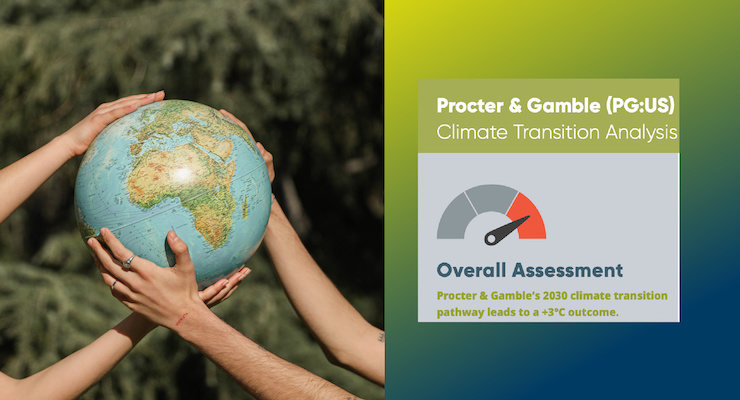07.06.23
As sustainability remains a growing concern for beauty brands, Planet Tracker just released its "Climate Transition Analysis" report on Procter & Gamble.
According to the report, P&G won't meet its emissions level goals recommended by the Science-Based Targets Initiative.
Planet Tracker says this is due to P&G’s failure to address upstream Scope 3 emissions—and it will result in a +3°C warming scenario by 2030. "P&G has not engaged effectively with its suppliers to reduce their emissions," the report states.
Planet Tracker is a non-profit that says it aims to "deliver a financial system that is fully aligned with a net-zero, nature-positive economy." Its report on P&G is of a comprehensive series examining the climate transition plans of consumer goods companies on the Climate Action 100+ list.
Ion Visinovschi, research analyst at Planet Tracker, says, "Procter and Gamble is the latest example of a major listed company failing to meaningfully tackle their upstream Scope 3 emissions. Under current projections, P&G's emissions could expose them to significant risks. We urge P&G to reassess their transition strategy and effectively address their upstream Scope 3 emissions."
Planet Tracker is calling on P&G to prioritize the reduction of their broader emissions profile, given the substantial economic and market risks associated with inaction.
Projecting P&G's Emissions
Planet Tracker’s analysis reveals notable limitations in P&G’s approach to Scope 3 emissions, with a substantial increase of 127% in upstream emissions between 2017 and 2021.This trend, coupled with the company’s current efforts, indicates a failure to effectively progress toward an alignment with the Paris Agreement. The report warns that such unchecked emissions growth are not in line with P&G’s sustainability targets, which include addressing upstream Scope 3 emissions in order to achieve Net Zero by 2040.
Additionally, Planet Tracker suggests that P&G may be significantly underestimating the risks associated with potential Carbon Pricing Mechanisms, which could result in a cost increase of USD 6.9 billion.
This is equivalent to 53% of P&G’s current five-year average annual operating profit. The report highlights that 51% of these costs can be attributed to P&G’s upstream Scope 3 emissions.
Planet Tracker's report projects P&G's emissions through 2030—and says that if the company takes no additional actions, here's how emissions will rise and/or fall:
- Scope 1 emissions are projected to increase at a rate of 0.8% per year
- Scope 2 emissions are projected to decrease at a rate of nearly 3% per year.
- Upstream Scope 3 emissions are expected to increase by over 22.7% per year, while downstream Scope 3 emissions are expected to decrease by close to 3.5% per year.
See Planet Tracker's full report here.
The 3 Types of Emissions—And What They Mean
Scope 1, Scope 2 and Scope 3 emissions are different categories of greenhouse gas emissions, the World Economic Forum (WEF) states. Scope 1 are direct emissions that a company causes, while Scope 2 are indirect emissions from purchased energy, including electricity, steam, heating, or cooling.Scope 3 emisisons are "those produced by customers using the company’s products or those produced by suppliers making products that the company uses," explains WEF in an article. Quoting consultant firm Deloitte, WEF states that Scope 3 emissions often account for more than 70% of a business’ carbon footprint.
Since Scope 3 emissions are often outside a company's direct control, measuring them involves tracking activities across the entire value chain, from suppliers to end users. The US Environmental Protection Agency suggests companies reduce their Scope 3 emissions by influencing their suppliers and choosing partners based on their carbon footprint.
Planet Tracker also has a report on Colgate-Palmolive.
Photo above on left via Pexels / Cup of Couple
Read More
A Growing Responsibility for Sustainable PackagingThe DNA of Sustainable Packaging at Aveda
Beauty Begins to Embrace Refillable Packaging













